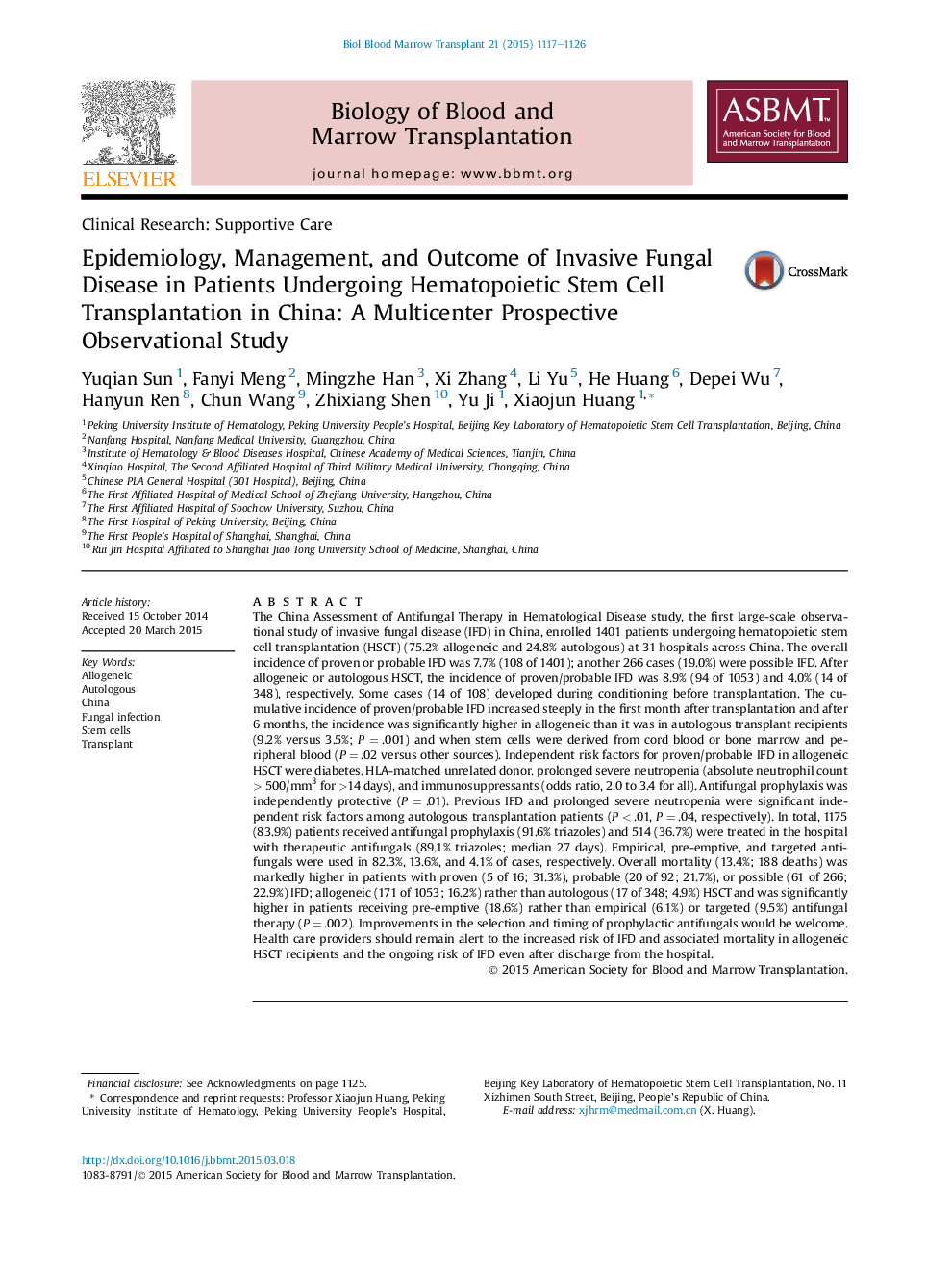| کد مقاله | کد نشریه | سال انتشار | مقاله انگلیسی | نسخه تمام متن |
|---|---|---|---|---|
| 2101561 | 1546266 | 2015 | 10 صفحه PDF | دانلود رایگان |
• Incidence of invasive fungal disease was 7.7% overall; 9.0% allogeneic hematopoietic stem cell transplantation and 4.3% autologous allogeneic hematopoietic stem cell transplantation.
• Cumulative incidence of invasive fungal disease increased steeply the first month after transplantation.
• Antifungal prophylaxis was independently protective against invasive fungal disease.
• Therapeutic antifungal rate was 40.6% (36.7% treated in the hospital, of whom 82.3% received empirical treatment).
• Invasive fungal disease substantially increased mortality.
The China Assessment of Antifungal Therapy in Hematological Disease study, the first large-scale observational study of invasive fungal disease (IFD) in China, enrolled 1401 patients undergoing hematopoietic stem cell transplantation (HSCT) (75.2% allogeneic and 24.8% autologous) at 31 hospitals across China. The overall incidence of proven or probable IFD was 7.7% (108 of 1401); another 266 cases (19.0%) were possible IFD. After allogeneic or autologous HSCT, the incidence of proven/probable IFD was 8.9% (94 of 1053) and 4.0% (14 of 348), respectively. Some cases (14 of 108) developed during conditioning before transplantation. The cumulative incidence of proven/probable IFD increased steeply in the first month after transplantation and after 6 months, the incidence was significantly higher in allogeneic than it was in autologous transplant recipients (9.2% versus 3.5%; P = .001) and when stem cells were derived from cord blood or bone marrow and peripheral blood (P = .02 versus other sources). Independent risk factors for proven/probable IFD in allogeneic HSCT were diabetes, HLA-matched unrelated donor, prolonged severe neutropenia (absolute neutrophil count > 500/mm3 for >14 days), and immunosuppressants (odds ratio, 2.0 to 3.4 for all). Antifungal prophylaxis was independently protective (P = .01). Previous IFD and prolonged severe neutropenia were significant independent risk factors among autologous transplantation patients (P < .01, P = .04, respectively). In total, 1175 (83.9%) patients received antifungal prophylaxis (91.6% triazoles) and 514 (36.7%) were treated in the hospital with therapeutic antifungals (89.1% triazoles; median 27 days). Empirical, pre-emptive, and targeted antifungals were used in 82.3%, 13.6%, and 4.1% of cases, respectively. Overall mortality (13.4%; 188 deaths) was markedly higher in patients with proven (5 of 16; 31.3%), probable (20 of 92; 21.7%), or possible (61 of 266; 22.9%) IFD; allogeneic (171 of 1053; 16.2%) rather than autologous (17 of 348; 4.9%) HSCT and was significantly higher in patients receiving pre-emptive (18.6%) rather than empirical (6.1%) or targeted (9.5%) antifungal therapy (P = .002). Improvements in the selection and timing of prophylactic antifungals would be welcome. Health care providers should remain alert to the increased risk of IFD and associated mortality in allogeneic HSCT recipients and the ongoing risk of IFD even after discharge from the hospital.
Journal: - Volume 21, Issue 6, June 2015, Pages 1117–1126
